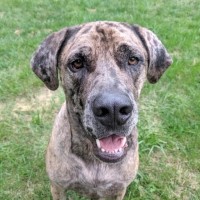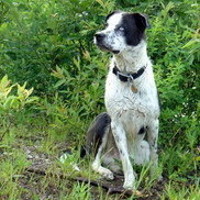Appearance of the English Mastahoula
|
| The English Mastahoula can vary in size from large to giant, and generally has a bulky but athletic appearance. Their head is broad, with a substantially built muzzle, which can vary from short to medium. Their small to medium-sized ears rest high on the head and fold forward or to the side, and their eyes are generally round, although they can be many colors due to their Catahoula Leopard Dog heritage, including eyes that include several colors a single eye and a blue so light it's almost white, a color known as glass. Like the Mastiff, the English Mastahoula will generally have loose, wrinkle-forming skin, especially around the head and neck, although this is probably less exaggerated in the crossbreed. This dog will generally have an easy-care double-layered coat consisting of a soft, dense undercoat covered by a short, stiff outer layer that lies flat against the body, although some of these dogs may have a short, stiff coat without an underlying layer. English Mastahoulas can come in a variety of colors, and robin is frequently seen in both the Catahoula and its offspring, the Mastahoula. |
Temperament of the English Mastahoula
|
| The Mastiff is generally a laid-back, dignified individual, while the Catahoula Leopard Dog has the focus, drive and energy that are characteristic of a serious working dog, and your English Mastahoula will most likely fall somewhere in between. Like their parent breeds, this hybrid requires daily interaction with their humans and can become quite destructive if bored or lonely. Training must also start at an early age, as both parent breeds are naturally protective and can become nervous or aggressive towards strangers and other animals if not properly socialized, and they can have a tendency to adopt dominant behaviors that can be mitigated by training. Their reactions to young children can be variable, as the Mastiff is generally very good with children, but the Catahoula Leopard Dog can be jealous and possessive, traits that don't sit well with small children. These dogs are very large and powerful, and all interactions between young children and dogs must be closely supervised to ensure the safety of everyone involved. |
Needs and activities of the English Mastahoula
|
| Although the Catahoula Leopard Dog is a very active breed, the Mastiff generally requires much less exercise than average for a dog of its size, so 60 to 90 minutes of vigorous activity a day is usually enough to keep this hybrid strong and healthy. In addition to daily walks, these dogs are adept at drawing and carting, agility training, tracking and hunting. During your dog's formative years, it's important to reduce the duration of exercise sessions by interrupting them throughout the day. Make sure your dog doesn't scramble or jump from great heights, as this can cause lifelong damage by affecting bones and joints still in formation. |
Maintenance of the English Mastahoula
|
| This hybrid has a short coat that makes grooming requirements quite manageable. Regular brushing with a soft bristle brush or curry comb is necessary to control shedding and distribute body oils, however, monthly baths are usually sufficient for these dogs. If your dog has inherited the folds and wrinkles commonly seen on Great Danes, precautions must be taken regularly to ensure that the skin folds have not trapped moisture, as this can cause skin irritation and a foul odor can develop, particularly around the face. They shed moderately all year round, although English Mastahoula with a double layer tend to shed more heavily than those with a single layer. |









 English (United Kingdom)
English (United Kingdom)